The image of a polar bear stranded on melting sea ice is often used as a symbol of the world’s rapidly changing climate. Yet every now and again, claims emerge in the media that polar bears’ plight might not be so serious after all.
Carbon Brief has dug through the literature on polar bears and climate change and spoken to experts from around the world to determine what a changing climate means for polar bears.
The consensus is clear – as Arctic sea ice melts, polar bears are finding it harder to hunt, mate and breed. While polar bears have shown some ability to adapt to changes in their surroundings – for example, by foraging for food on land, or swimming more to hunt for prey – scientists project that as sea ice diminishes, polar bears will find it harder to survive and populations will decline.
Polar bears and sea ice loss
Polar bears depend on sea ice for most important aspects of their lives – including hunting, mating and resting. While polar bears are strong swimmers, capable of swimming for hours on end, they find swimming much more energy intensive than walking. As such, sea ice is crucial for polar bears to survive.
However, temperatures in the Arctic are rising nearly four times as fast as the global average, and Arctic sea ice extent has declined since 1979 for every month of the year. The chart below shows how Arctic sea ice extent has diminished in recent decades.
Source: NSIDC Sea Ice Index v3.0, APL/PSC PIOMAS v2.1 Note the truncated axis.Changes in Arctic Sea Ice, 1980 - 2022
Extent, million km2
Volume, km3
Prof Andrew Derocher is an expert in polar bear ecology and conservation at the University of Alberta. He tells Carbon Brief that “without sea ice, there is no sea ice ecosystem – and losing that ecosystem includes losing polar bears”.
Scientists have defined 19 key regions where polar bears live, extending across Arctic regions of Canada, Greenland, Norway, Russian and the US. All 19 subpopulations of polar bears have experienced some degree of ice loss.
The 19 polar bear subpopulations can be grouped into four “ecoregions”, based on the annual pattern of sea ice loss and gain, as shown by the different colours on the map below. Purple, blue, yellow and red indicate archipelago, convergent, divergent and seasonal regions, respectively. Click on each subregion to learn more about its polar bear population.
The 19 polar bear subpopulations can be grouped into four “ecoregions”, based on the annual pattern of sea ice loss and gain
| Population region | Ecoregions |
|---|---|
| Gulf of Boothia | Archipelago |
| Kane Basin | Archipelago |
| Lancaster Sounds | Archipelago |
| M’Clintock Channel | Archipelago |
| Norwegian Bay | Archipelago |
| Viscount Melville Sound | Archipelago |
| East Greenland | Convergent |
| Northern Beaufort Sea | Convergent |
| Barents Sea | Divergent |
| Chukchi Sea | Divergent |
| Kara Sea | Divergent |
| Laptev Sea | Divergent |
| Southern Beaufort Sea | Divergent |
| Baffin Bay | Seasonal |
| Davis Strait | Seasonal |
| Foxe Basin | Seasonal |
| Southern Hudson Bay | Seasonal |
| Western Hudson Bay | Seasonal |
Ecoregions provided by Eric Regehr. Text source: IUCN (2021).
The Arctic Basin (AB) subpopulation likely has few year-round resident polar bears and is generally excluded from analyses.
The four ecoregions are categorised by different seasonal ice melt and growth patterns. The latest Polar Bear Specialist Group status report (pdf) outlines the patterns of ice coverage for each one:
- Seasonal: The “rich environment” allows bears to gain weight in spring. But in summer, the ice melts completely – so polar bears are forced ashore and largely live off their fat reserves until ice reforms.
- Divergent: This region has historically had ice coverage all year round. However, as the climate warms, the sea ice is retreating farther from shore.
- Convergent: In this region, ice collects along the shore in summer, allowing the bears to remain on sea ice all-year round.
- Archipelago: Full ice coverage all year round. This region is “likely to provide a last refuge for polar bears and their prey”.
A review published in 2016 finds that “loss of Arctic sea ice owing to climate change is the primary threat to polar bears throughout their range”. The paper plots sea-ice concentration in 18 of the 19 key regions over 1979-2014. It shows that ice decline is more notable in some regions than others. Analysis was not conducted for the 19th subpopulation – the Arctic Basin – due to the small polar bear subpopulation.
The lines show the rate of decline in ice covered days/ year over the period Source: Regehr et al 2016 Within each of the 19 subpopulation areas,
daily sea-ice area was calculated by summing the product of
ice concentration and grid cell area over all 25x25 km grid
cells with concentration more than 15%.
The midpoint between summer-minimum and winter-maximum
ice areas was determined, and the number of days per
year that ice area was above the midpoint calculated (i.e. the number of "icecovered" days).Between 1979 and 2014 the number of "ice covered" days decreased for 18 of the 19 polar bear subpopulations
Baffin Bay

Barents Sea

Chukchi Sea

Davis Strait

East Greenland

Foxe Basin

Gulf of Boothia

Kane Basin

Kara Sea
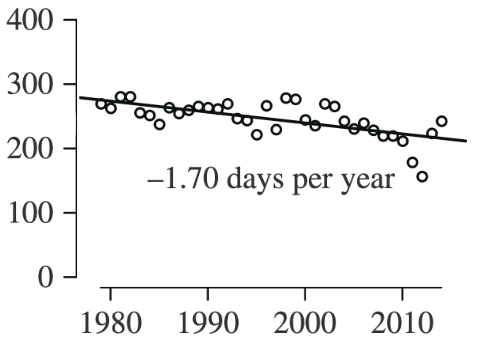
Laptev Sea

Lancaster Sounds

M’Clintock Channel

Northern Beaufort Sea

Norwegian Bay
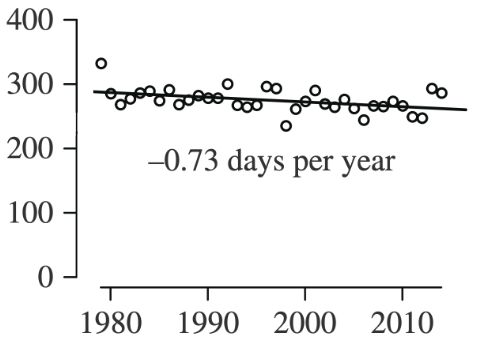
Southern Beaufort Sea

Southern Hudson Bay
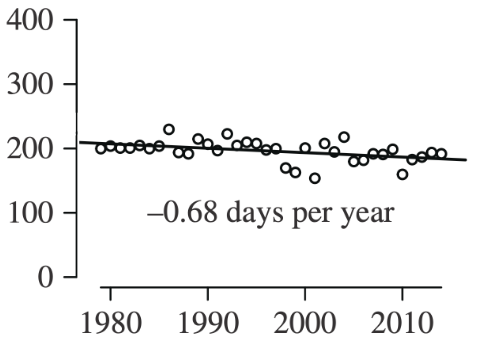
Viscount Melville Sound

Western Hudson Bay
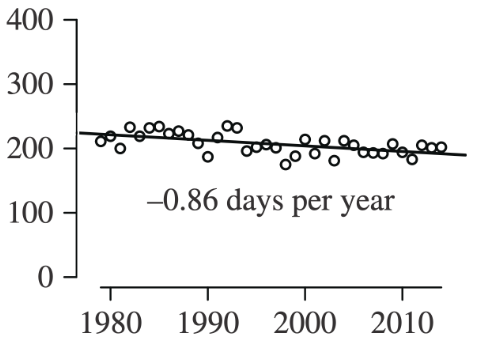
The differing behaviour of sea ice across the Arctic means that not all polar bear populations will respond in the same way to thinning ice.
In subregions including the Southern Beaufort Sea, Baffin Bay and Western Hudson Bay, sea-ice loss has been directly linked to past or present declines in the polar bear population. For example, the video below shows how polar bears from the Western Hudson Bay migrate throughout the year in response to the annual cycle of growing and shrinking Arctic sea ice.
However, in regions such as the Kane Basin, which is part of the “archipelago” group, a shift from thick, multi-year ice to thinner, seasonal ice has proved beneficial for bears. Dr Eric Regehr – a polar bear expert at the University of Washington – tells Carbon Brief why thinning ice could, temporarily, help some polar bears:
“Historically, there was actually too much sea ice in the high Arctic for bears. The multi-year sea ice can be 10 metres thick, so it stifles productivity. So there is a transient phenomenon where in some of these high Arctic areas, as it’s getting warmer and sea ice is melting, the conditions are getting to be just right.
“It is important to recognise that we fully expect this to be a transient phenomenon, given that climate change today is being driven by greenhouse gas emissions, and that’s kind of a one way driver.”
It can be difficult to produce direct counts of polar bear numbers in the more remote parts of the Arctic, which means that scientists know a lot more about some polar bear populations than others.
Hunting and fasting
Polar bears most often feed on ringed seals that live at the ice edge, waiting for hours – or even days – for seals to emerge at breathing holes in the ice. Polar bear diets can also include bearded seals, harp seals and walruses.
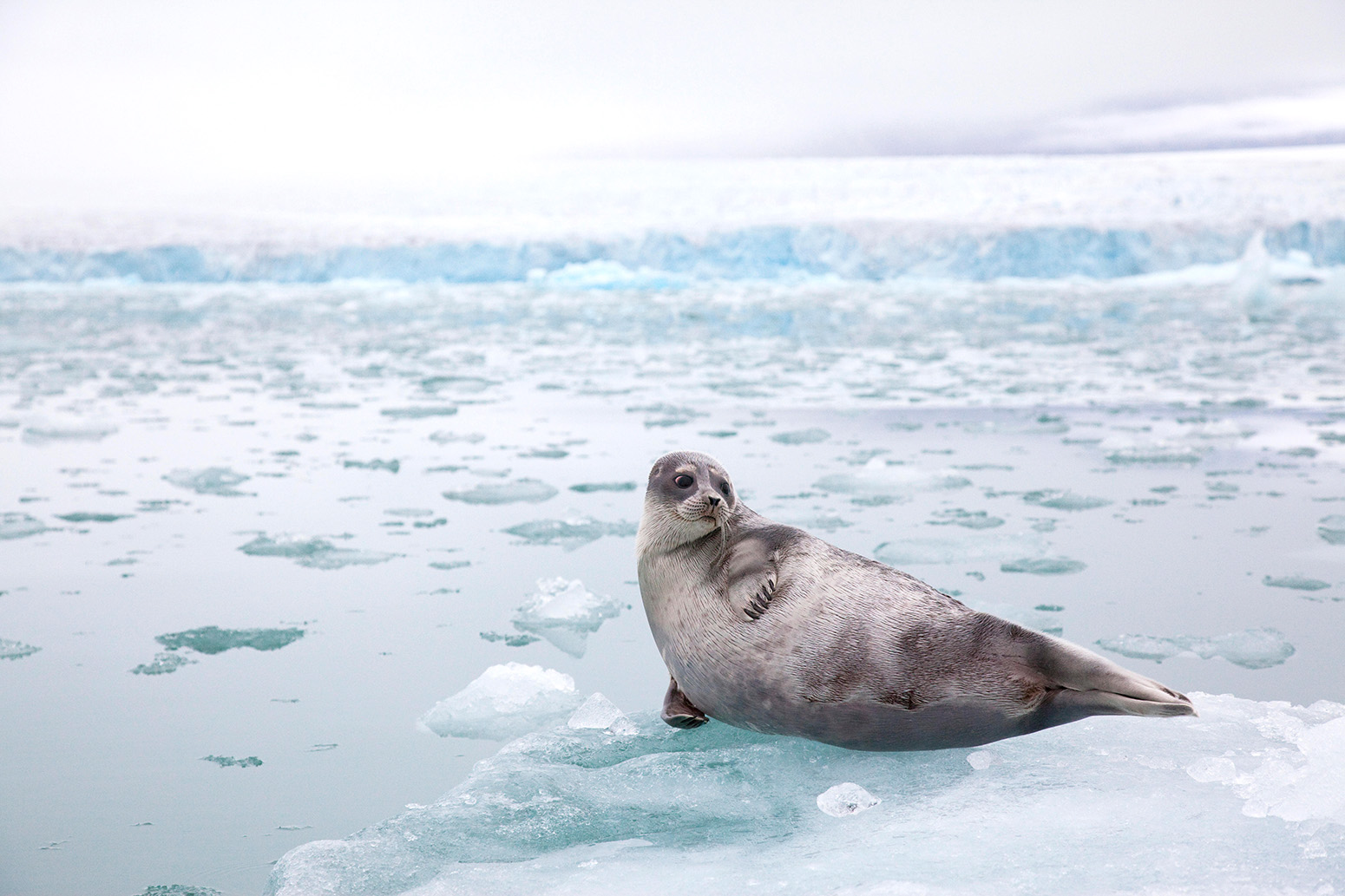
A ringed seal, Svalbard, Norway. Credit: Nature Picture Library / Alamy Stock Photo.
Polar bears get around two-thirds of their energy for the entire year in late spring and early summer, when prey is abundant. They then fast throughout much of the autumn and winter when prey is scarce.
However, as the climate warms, sea ice is retreating earlier in spring and forming later in winter. This gives polar bears less time to hunt, forcing them to go without food for longer and swim greater distances.
This extra exertion and lack of food can drive a decline in body condition and cause a drop in the average weight of adult bears. Meanwhile, fewer bear cubs survive and those that do are smaller.
One study, investigating how ice melt will affect bears’ fasting lengths over the coming century, concludes:
“With high greenhouse gas emissions, steeply declining reproduction and survival will jeopardise the persistence of all but a few high-Arctic subpopulations by 2100. Moderate emissions mitigation prolongs persistence but is unlikely to prevent some subpopulation extirpations within this century.”
The paper identifies a fasting “threshold” for adult males, adult females and cubs. The authors estimate that cubs can survive around 117 days without food during this fasting period, while adult male and female polar bears can survive longer. They then explore expected sea-ice loss under different warming scenarios to determine when polar bears might start experiencing impacts from extended fasting.
The chart shows the expected “year of first impact” from extended fasting, for cubs, adult female, and adult males bears, in both high (top) and mid (bottom) emissions scenarios. Each line shows a different polar bear subregion. The risk of impact increases as the colour of the line darkens – from “possible” impacts in light blue, to “inevitable” impacts in red.
Bears living on seasonal ice will see the greatest threat from warming over the coming decades. Cubs see more severe impacts from extended fasting than adult bears
Possible, likely, very likely, inevitable impact.
Cub recruitment
High emissions scenario (RCP8.5)
Mid emissions scenario (RCP4.5)
Adult female survival
High emissions scenario (RCP8.5)
Mid emissions scenario (RCP4.5)
Adult male survival
High emissions scenario (RCP8.5)
Mid emissions scenario (RCP4.5)
Source: Chart made by Carbon Brief using data from Molnar et al
Years when projected annual fasting period lengths exceed cub recruitment (growth to adulthood), and adult survival impact thresholds in different subpopulation regions.
Polar bear impacts
As the climate warms, polar bears are being forced to change their behaviour, and their phenology – the timing of seasonal biological events, such as denning and breeding – is shifting.
For example, research shows that as polar bears lose access to their typical diet of seals, they are becoming increasingly reliant on other types of food, including whale carcasses, sea duck eggs and reindeer.
Derocher tells Carbon Brief that as polar bears are being forced to spend more time on land, they are more likely to be seen in human rubbish dumps as they “seek alternative foods”. He adds that this raises questions around “human-bear interactions”. For example, research finds that longer ice-free periods are linked to increasing conflict between humans and polar bears.
Meanwhile, female bears in the European Arctic now have only one-third as much denning habitat available as in the 1980s. And unusually warm weather in winter can cause the collapse of dens that females build to birth and protect their young. One study finds that female polar bears give birth to smaller litters of cubs when there are longer summer ice-free periods.
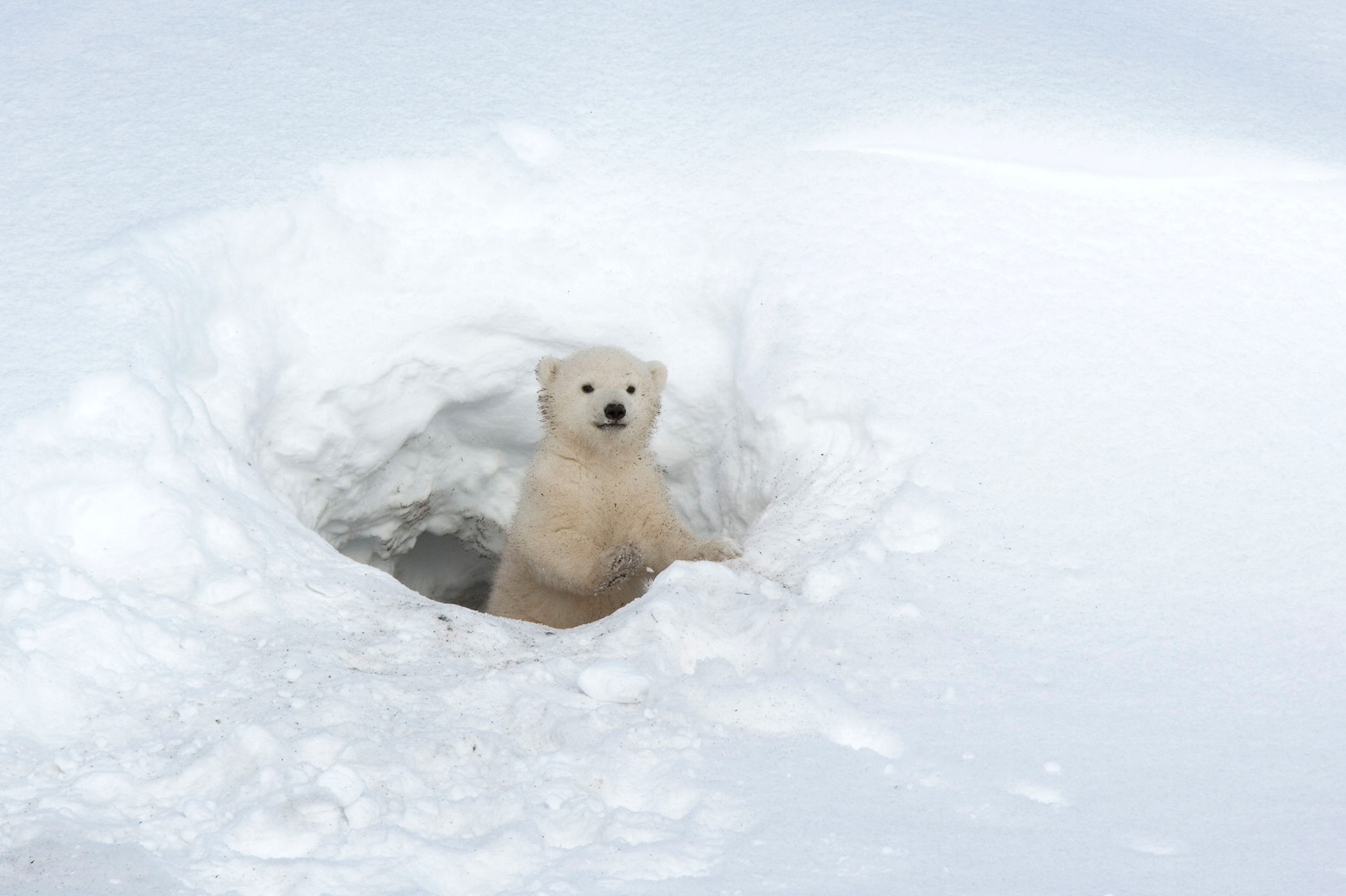
A polar bear cub looking out of a den, Hudson Bay, Canada. Credit: Robert Harding / Alamy Stock Photo.
The Intergovernmental Panel on Climate Change’s special report on the ocean and cryosphere, published in 2019, outlines the impact of declining sea ice and snow on polar bears:
“Changes in the timing, distribution and thickness of sea ice and snow have been linked to phenological shifts, and changes in distribution, denning, foraging behaviour and survival rates of polar bears (high confidence). Less ice is also driving polar bears to travel over greater distances and swim more than previously – both in offshore and in coastal areas, which can be particularly dangerous for young cubs.”
Meanwhile, ice fragmentation is reducing many polar bears’ range of travel and causing polar bear subpopulations to become increasingly isolated. Warming has also been linked to increases in contamination and exposure to diseases.
Other factors such as hunting, shipping, oil-and-gas activities, tourism, prey availability and successful conservation also come into play to greater or lesser extents.
While polar bears have shown some ability to adapt to changes in their surroundings – for example, by foraging for food on land or swimming more to hunt for prey – scientists project that polar bears will become more food-stressed as sea ice diminishes and that populations will decline.
Latest counts
Every few years, the International Union for the Conservation of Nature (IUCN) publishes a “Red List” – an overview of the conservation status of threatened animal and plant species. The latest assessment for polar bears, published in 2015, classifies them as “vulnerable”, meaning they are facing a high risk of extinction in the wild.
Scientists estimate that there is a 70% chance the global population of polar bears will fall by more than a third within the next three generations.
Prof Charlotte Lindqvist, an expert in polar bears and climate change at the University of Buffalo, tells Carbon Brief:
“[The data] shows a significant decline in sea ice throughout the entire polar bear range over the last 35 years, and if this trend continues…the future looks dire for the polar bear species.”
However, scientists also think the risk of polar bear numbers dropping by more than half in the next 35 years is low (7%), while the risk of an 80% collapse is negligible. This means that polar bears do not meet the criteria of the IUCN’s more serious “endangered” category.
What needs to happen for polar bears to shift a category in the other direction, from “vulnerable” to the less-severe “near threatened”? Dena Cator – former coordinator of the Species Survival Commission at the IUCN – is clear on this point:
“The single most important factor to improve the long-term survival of polar bears is reducing greenhouse gas emissions and stabilising Arctic sea ice.”
The IUCN assessment does not look at the extinction risk for polar bears over a time span of longer than about 35 years – or three generations of polar bears. But without action to tackle climate change, it is likely that many polar bear subpopulations will cross “tipping points” over the next century if sea-ice loss continues as forecasted, says Cator.
Overall, the IUCN estimates the total number of polar bears at 26,000, with only a 5% chance that it is less than 22,000 or more than 31,000. And on the data available, the latest IUCN assessment says that three polar bear subpopulations are currently in decline, while none have seen a population increase over the last two generations.
As several polar bear subpopulations lack abundance estimates, and there is high uncertainty about the numbers that do exist, scientists are wary of trying to pinpoint the absolute size of the global polar bear population.
A recent study has also documented a 20th polar bear subpopulation – the Southeast Greenland population – for the first time.
However, the trend in populations for which there is data points to a species in decline, compared to two or three decades ago. And with the impacts of warming on polar bear habitat and feeding well-understood, scientists are clear that polar bears face a profound threat to their survival in the coming decades.
In light of growing concern, the US, Canada, Norway, Greenland and Russia all signed a Circumpolar Action Plan (CAP) in September 2015. This 10-year cooperation plan aims to “secure the long-term persistence of polar bears in the wild that represent the genetic, behavioural, life-history and ecological diversity of the species”, through seven key objectives.
A mid-term review, held in 2020, assessed “the degree to which the actions have been implemented, the effectiveness of actions to achieving the stated objectives, and the impact of those actions toward achieving the vision”.
A press release (pdf) released following the review said that, of 10 key threats identified, “human-caused climate change and the effects of such changes on polar bear habitat and prey is considered the primary threat”. It emphasised “the need for the global community to reduce greenhouse gas emissions in order to conserve polar bears and their habitat”.
Progress on their 2020-23 implementation plan will be reported prior to a planned meeting of the parties in 2023.
Notes
8 December 2022. This article underwent a significant update to include the latest numbers from the IUCN report, interactive graphics and new literature.
22 Mar 2017. This article was updated to include a discussion of recent polar bears counts in Baffin Bay and Kane Basin, published since the last International Union for the Conservation of Nature (IUCN) assessment.
23 Dec 2016. This article was updated to include the latest IUCN Red List and extra comment from scientists. A paper detailing the conservation status of polar bears, the data from which underpinned the IUCN assessment, was published in Royal Society Biology Letters in December 2016.
4 March 2015. This article was updated to include the most recent polar bear subpopulation map from the IUCD/PBSG and further explanation.